ACCT19083: Term 3, 2017 Final Assignment: SRB and Ethics
VerifiedAdded on 2020/05/16
|21
|6153
|86
Homework Assignment
AI Summary
This assignment, completed for ACCT19083, delves into the concept of socially responsible businesses (SRB), exploring the definition, principles, and real-world examples like the Grameen Bank in Bangladesh. The assignment analyzes whether Grameen Bank qualifies as an SRB, highlighting its microfinance model and impact on poverty alleviation. Furthermore, it discusses ethical dilemmas, providing a definition and an example of a situation where management pressures employees for increased production without proper incentives. The student draws upon academic references to support the arguments and provides a comprehensive understanding of the topics.
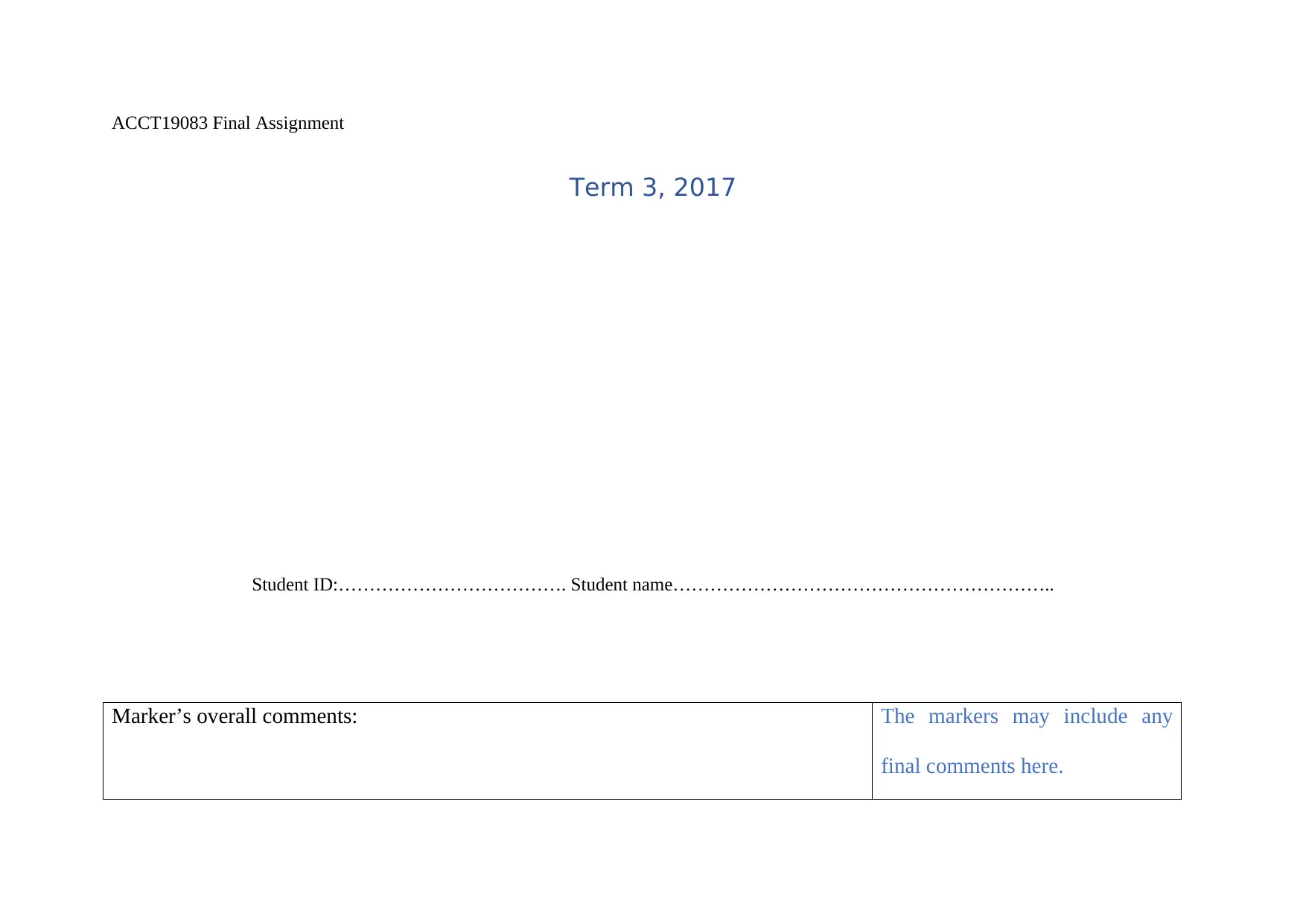
ACCT19083 Final Assignment
Term 3, 2017
Student ID:………………………………. Student name……………………………………………………..
Marker’s overall comments: The markers may include any
final comments here.
Term 3, 2017
Student ID:………………………………. Student name……………………………………………………..
Marker’s overall comments: The markers may include any
final comments here.
Paraphrase This Document
Need a fresh take? Get an instant paraphrase of this document with our AI Paraphraser
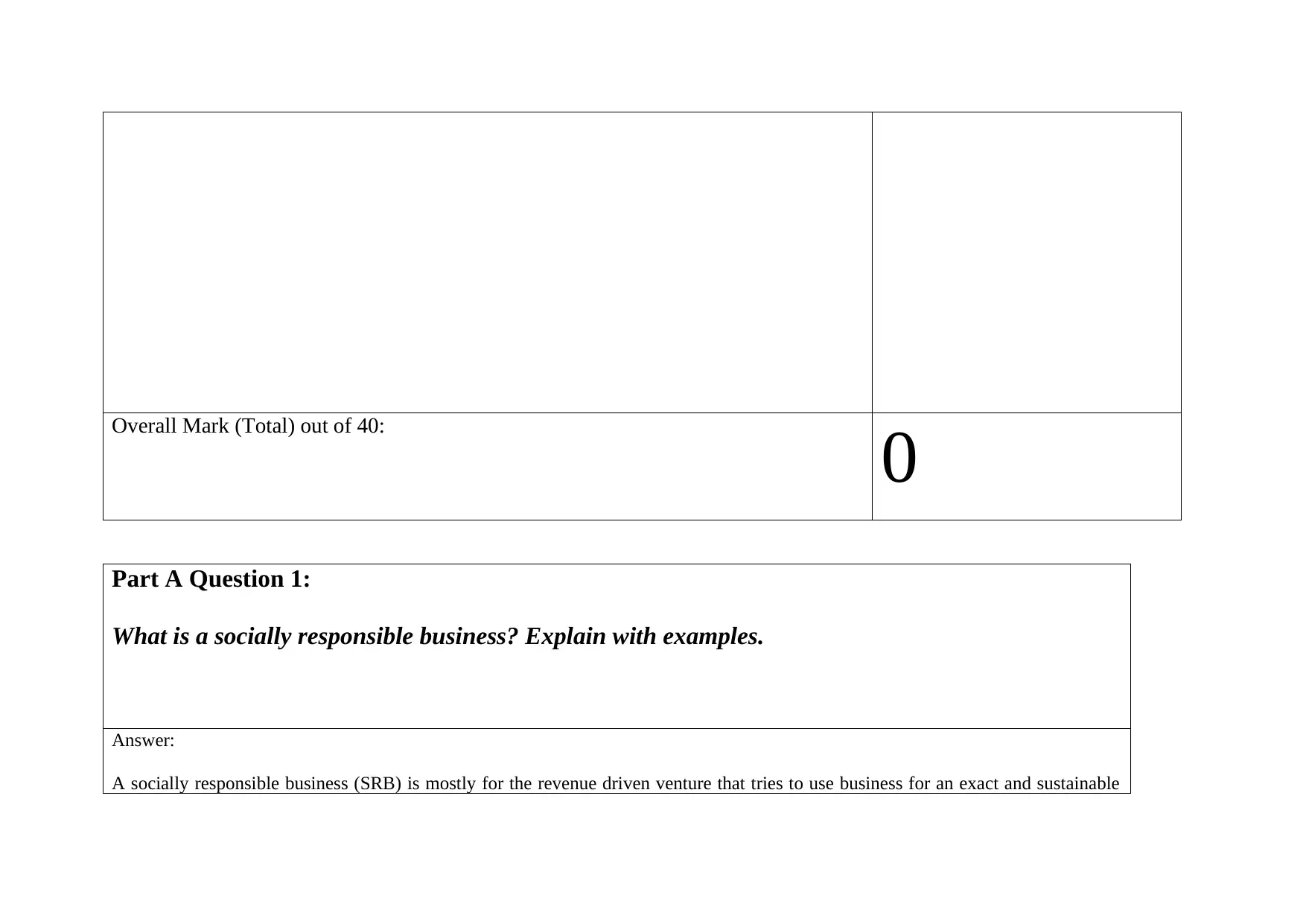
Overall Mark (Total) out of 40:
0
Part A Question 1:
What is a socially responsible business? Explain with examples.
Answer:
A socially responsible business (SRB) is mostly for the revenue driven venture that tries to use business for an exact and sustainable
0
Part A Question 1:
What is a socially responsible business? Explain with examples.
Answer:
A socially responsible business (SRB) is mostly for the revenue driven venture that tries to use business for an exact and sustainable
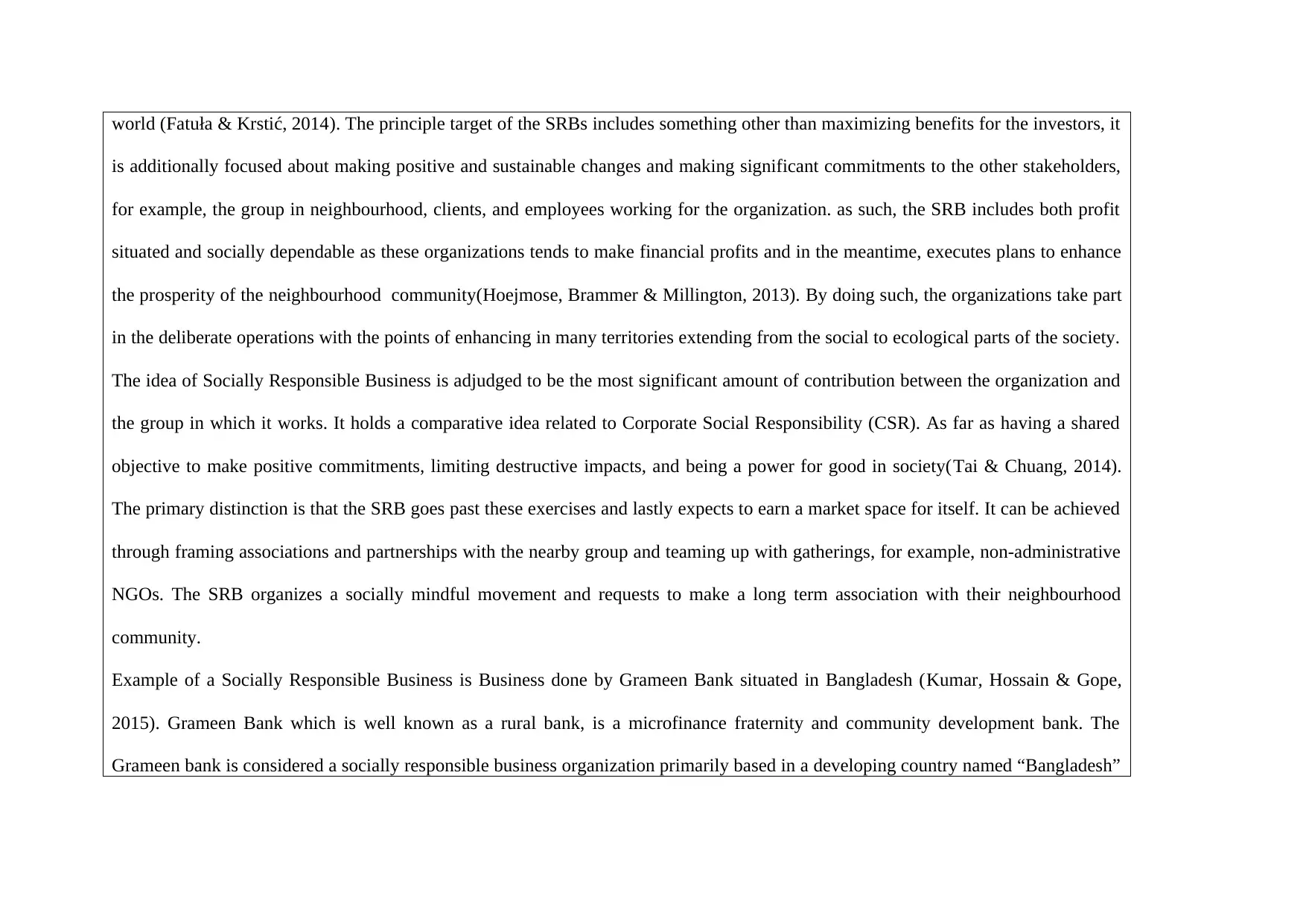
world (Fatuła & Krstić, 2014). The principle target of the SRBs includes something other than maximizing benefits for the investors, it
is additionally focused about making positive and sustainable changes and making significant commitments to the other stakeholders,
for example, the group in neighbourhood, clients, and employees working for the organization. as such, the SRB includes both profit
situated and socially dependable as these organizations tends to make financial profits and in the meantime, executes plans to enhance
the prosperity of the neighbourhood community(Hoejmose, Brammer & Millington, 2013). By doing such, the organizations take part
in the deliberate operations with the points of enhancing in many territories extending from the social to ecological parts of the society.
The idea of Socially Responsible Business is adjudged to be the most significant amount of contribution between the organization and
the group in which it works. It holds a comparative idea related to Corporate Social Responsibility (CSR). As far as having a shared
objective to make positive commitments, limiting destructive impacts, and being a power for good in society(Tai & Chuang, 2014).
The primary distinction is that the SRB goes past these exercises and lastly expects to earn a market space for itself. It can be achieved
through framing associations and partnerships with the nearby group and teaming up with gatherings, for example, non-administrative
NGOs. The SRB organizes a socially mindful movement and requests to make a long term association with their neighbourhood
community.
Example of a Socially Responsible Business is Business done by Grameen Bank situated in Bangladesh (Kumar, Hossain & Gope,
2015). Grameen Bank which is well known as a rural bank, is a microfinance fraternity and community development bank. The
Grameen bank is considered a socially responsible business organization primarily based in a developing country named “Bangladesh”
is additionally focused about making positive and sustainable changes and making significant commitments to the other stakeholders,
for example, the group in neighbourhood, clients, and employees working for the organization. as such, the SRB includes both profit
situated and socially dependable as these organizations tends to make financial profits and in the meantime, executes plans to enhance
the prosperity of the neighbourhood community(Hoejmose, Brammer & Millington, 2013). By doing such, the organizations take part
in the deliberate operations with the points of enhancing in many territories extending from the social to ecological parts of the society.
The idea of Socially Responsible Business is adjudged to be the most significant amount of contribution between the organization and
the group in which it works. It holds a comparative idea related to Corporate Social Responsibility (CSR). As far as having a shared
objective to make positive commitments, limiting destructive impacts, and being a power for good in society(Tai & Chuang, 2014).
The primary distinction is that the SRB goes past these exercises and lastly expects to earn a market space for itself. It can be achieved
through framing associations and partnerships with the nearby group and teaming up with gatherings, for example, non-administrative
NGOs. The SRB organizes a socially mindful movement and requests to make a long term association with their neighbourhood
community.
Example of a Socially Responsible Business is Business done by Grameen Bank situated in Bangladesh (Kumar, Hossain & Gope,
2015). Grameen Bank which is well known as a rural bank, is a microfinance fraternity and community development bank. The
Grameen bank is considered a socially responsible business organization primarily based in a developing country named “Bangladesh”
⊘ This is a preview!⊘
Do you want full access?
Subscribe today to unlock all pages.

Trusted by 1+ million students worldwide
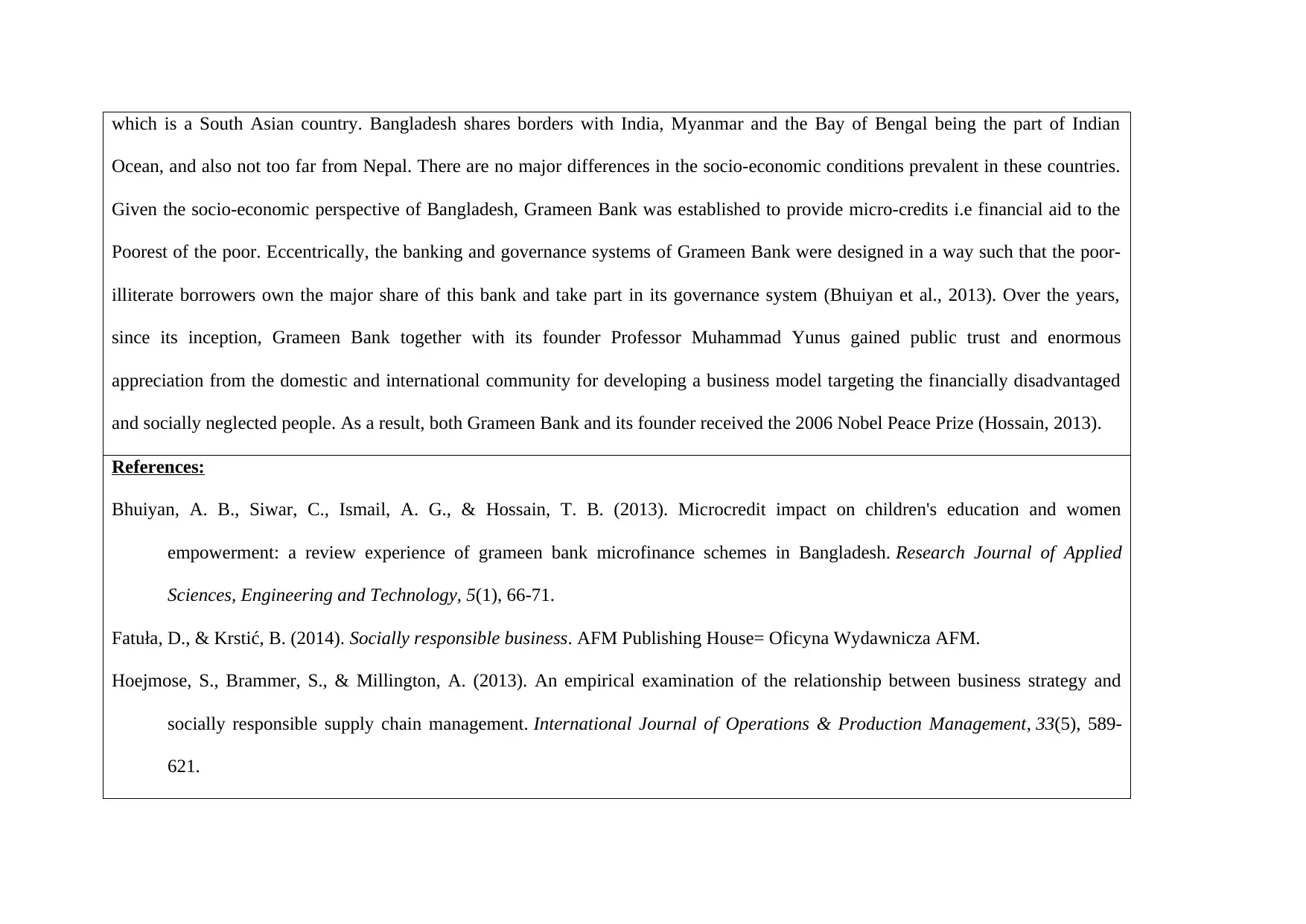
which is a South Asian country. Bangladesh shares borders with India, Myanmar and the Bay of Bengal being the part of Indian
Ocean, and also not too far from Nepal. There are no major differences in the socio-economic conditions prevalent in these countries.
Given the socio-economic perspective of Bangladesh, Grameen Bank was established to provide micro-credits i.e financial aid to the
Poorest of the poor. Eccentrically, the banking and governance systems of Grameen Bank were designed in a way such that the poor-
illiterate borrowers own the major share of this bank and take part in its governance system (Bhuiyan et al., 2013). Over the years,
since its inception, Grameen Bank together with its founder Professor Muhammad Yunus gained public trust and enormous
appreciation from the domestic and international community for developing a business model targeting the financially disadvantaged
and socially neglected people. As a result, both Grameen Bank and its founder received the 2006 Nobel Peace Prize (Hossain, 2013).
References:
Bhuiyan, A. B., Siwar, C., Ismail, A. G., & Hossain, T. B. (2013). Microcredit impact on children's education and women
empowerment: a review experience of grameen bank microfinance schemes in Bangladesh. Research Journal of Applied
Sciences, Engineering and Technology, 5(1), 66-71.
Fatuła, D., & Krstić, B. (2014). Socially responsible business. AFM Publishing House= Oficyna Wydawnicza AFM.
Hoejmose, S., Brammer, S., & Millington, A. (2013). An empirical examination of the relationship between business strategy and
socially responsible supply chain management. International Journal of Operations & Production Management, 33(5), 589-
621.
Ocean, and also not too far from Nepal. There are no major differences in the socio-economic conditions prevalent in these countries.
Given the socio-economic perspective of Bangladesh, Grameen Bank was established to provide micro-credits i.e financial aid to the
Poorest of the poor. Eccentrically, the banking and governance systems of Grameen Bank were designed in a way such that the poor-
illiterate borrowers own the major share of this bank and take part in its governance system (Bhuiyan et al., 2013). Over the years,
since its inception, Grameen Bank together with its founder Professor Muhammad Yunus gained public trust and enormous
appreciation from the domestic and international community for developing a business model targeting the financially disadvantaged
and socially neglected people. As a result, both Grameen Bank and its founder received the 2006 Nobel Peace Prize (Hossain, 2013).
References:
Bhuiyan, A. B., Siwar, C., Ismail, A. G., & Hossain, T. B. (2013). Microcredit impact on children's education and women
empowerment: a review experience of grameen bank microfinance schemes in Bangladesh. Research Journal of Applied
Sciences, Engineering and Technology, 5(1), 66-71.
Fatuła, D., & Krstić, B. (2014). Socially responsible business. AFM Publishing House= Oficyna Wydawnicza AFM.
Hoejmose, S., Brammer, S., & Millington, A. (2013). An empirical examination of the relationship between business strategy and
socially responsible supply chain management. International Journal of Operations & Production Management, 33(5), 589-
621.
Paraphrase This Document
Need a fresh take? Get an instant paraphrase of this document with our AI Paraphraser
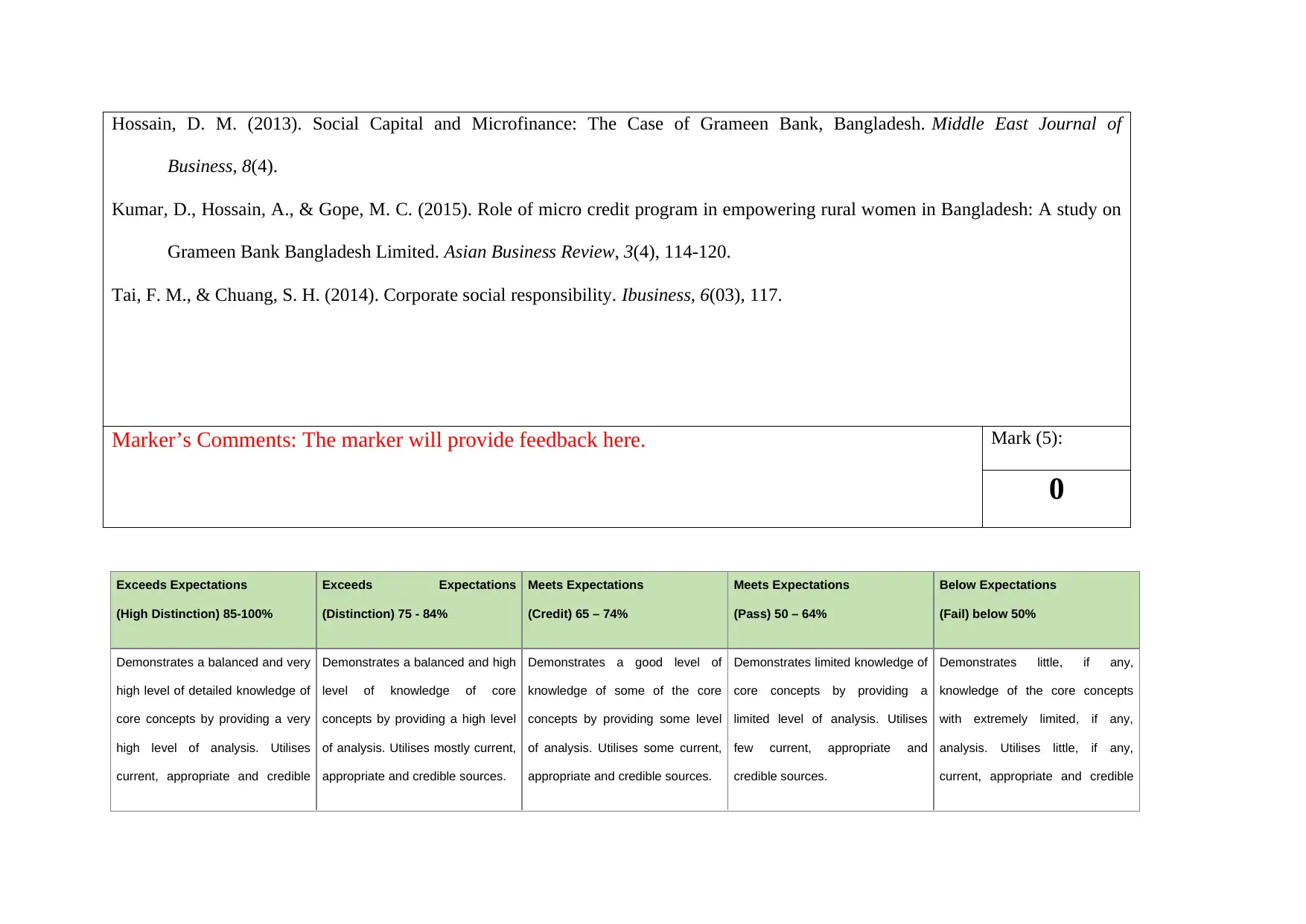
Hossain, D. M. (2013). Social Capital and Microfinance: The Case of Grameen Bank, Bangladesh. Middle East Journal of
Business, 8(4).
Kumar, D., Hossain, A., & Gope, M. C. (2015). Role of micro credit program in empowering rural women in Bangladesh: A study on
Grameen Bank Bangladesh Limited. Asian Business Review, 3(4), 114-120.
Tai, F. M., & Chuang, S. H. (2014). Corporate social responsibility. Ibusiness, 6(03), 117.
Marker’s Comments: The marker will provide feedback here. Mark (5):
0
Exceeds Expectations
(High Distinction) 85-100%
Exceeds Expectations
(Distinction) 75 - 84%
Meets Expectations
(Credit) 65 – 74%
Meets Expectations
(Pass) 50 – 64%
Below Expectations
(Fail) below 50%
Demonstrates a balanced and very
high level of detailed knowledge of
core concepts by providing a very
high level of analysis. Utilises
current, appropriate and credible
Demonstrates a balanced and high
level of knowledge of core
concepts by providing a high level
of analysis. Utilises mostly current,
appropriate and credible sources.
Demonstrates a good level of
knowledge of some of the core
concepts by providing some level
of analysis. Utilises some current,
appropriate and credible sources.
Demonstrates limited knowledge of
core concepts by providing a
limited level of analysis. Utilises
few current, appropriate and
credible sources.
Demonstrates little, if any,
knowledge of the core concepts
with extremely limited, if any,
analysis. Utilises little, if any,
current, appropriate and credible
Business, 8(4).
Kumar, D., Hossain, A., & Gope, M. C. (2015). Role of micro credit program in empowering rural women in Bangladesh: A study on
Grameen Bank Bangladesh Limited. Asian Business Review, 3(4), 114-120.
Tai, F. M., & Chuang, S. H. (2014). Corporate social responsibility. Ibusiness, 6(03), 117.
Marker’s Comments: The marker will provide feedback here. Mark (5):
0
Exceeds Expectations
(High Distinction) 85-100%
Exceeds Expectations
(Distinction) 75 - 84%
Meets Expectations
(Credit) 65 – 74%
Meets Expectations
(Pass) 50 – 64%
Below Expectations
(Fail) below 50%
Demonstrates a balanced and very
high level of detailed knowledge of
core concepts by providing a very
high level of analysis. Utilises
current, appropriate and credible
Demonstrates a balanced and high
level of knowledge of core
concepts by providing a high level
of analysis. Utilises mostly current,
appropriate and credible sources.
Demonstrates a good level of
knowledge of some of the core
concepts by providing some level
of analysis. Utilises some current,
appropriate and credible sources.
Demonstrates limited knowledge of
core concepts by providing a
limited level of analysis. Utilises
few current, appropriate and
credible sources.
Demonstrates little, if any,
knowledge of the core concepts
with extremely limited, if any,
analysis. Utilises little, if any,
current, appropriate and credible
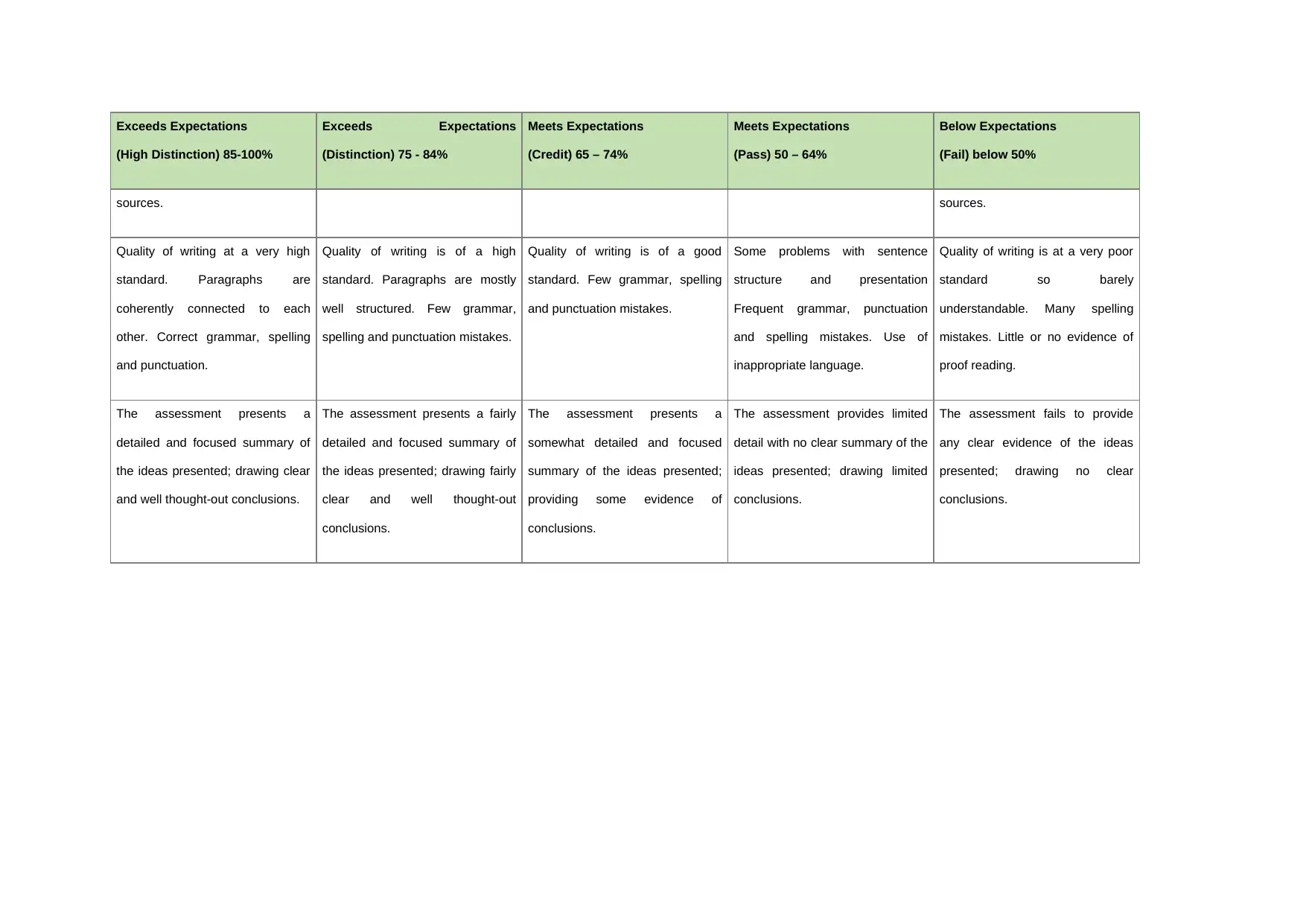
Exceeds Expectations
(High Distinction) 85-100%
Exceeds Expectations
(Distinction) 75 - 84%
Meets Expectations
(Credit) 65 – 74%
Meets Expectations
(Pass) 50 – 64%
Below Expectations
(Fail) below 50%
sources. sources.
Quality of writing at a very high
standard. Paragraphs are
coherently connected to each
other. Correct grammar, spelling
and punctuation.
Quality of writing is of a high
standard. Paragraphs are mostly
well structured. Few grammar,
spelling and punctuation mistakes.
Quality of writing is of a good
standard. Few grammar, spelling
and punctuation mistakes.
Some problems with sentence
structure and presentation
Frequent grammar, punctuation
and spelling mistakes. Use of
inappropriate language.
Quality of writing is at a very poor
standard so barely
understandable. Many spelling
mistakes. Little or no evidence of
proof reading.
The assessment presents a
detailed and focused summary of
the ideas presented; drawing clear
and well thought-out conclusions.
The assessment presents a fairly
detailed and focused summary of
the ideas presented; drawing fairly
clear and well thought-out
conclusions.
The assessment presents a
somewhat detailed and focused
summary of the ideas presented;
providing some evidence of
conclusions.
The assessment provides limited
detail with no clear summary of the
ideas presented; drawing limited
conclusions.
The assessment fails to provide
any clear evidence of the ideas
presented; drawing no clear
conclusions.
(High Distinction) 85-100%
Exceeds Expectations
(Distinction) 75 - 84%
Meets Expectations
(Credit) 65 – 74%
Meets Expectations
(Pass) 50 – 64%
Below Expectations
(Fail) below 50%
sources. sources.
Quality of writing at a very high
standard. Paragraphs are
coherently connected to each
other. Correct grammar, spelling
and punctuation.
Quality of writing is of a high
standard. Paragraphs are mostly
well structured. Few grammar,
spelling and punctuation mistakes.
Quality of writing is of a good
standard. Few grammar, spelling
and punctuation mistakes.
Some problems with sentence
structure and presentation
Frequent grammar, punctuation
and spelling mistakes. Use of
inappropriate language.
Quality of writing is at a very poor
standard so barely
understandable. Many spelling
mistakes. Little or no evidence of
proof reading.
The assessment presents a
detailed and focused summary of
the ideas presented; drawing clear
and well thought-out conclusions.
The assessment presents a fairly
detailed and focused summary of
the ideas presented; drawing fairly
clear and well thought-out
conclusions.
The assessment presents a
somewhat detailed and focused
summary of the ideas presented;
providing some evidence of
conclusions.
The assessment provides limited
detail with no clear summary of the
ideas presented; drawing limited
conclusions.
The assessment fails to provide
any clear evidence of the ideas
presented; drawing no clear
conclusions.
⊘ This is a preview!⊘
Do you want full access?
Subscribe today to unlock all pages.

Trusted by 1+ million students worldwide
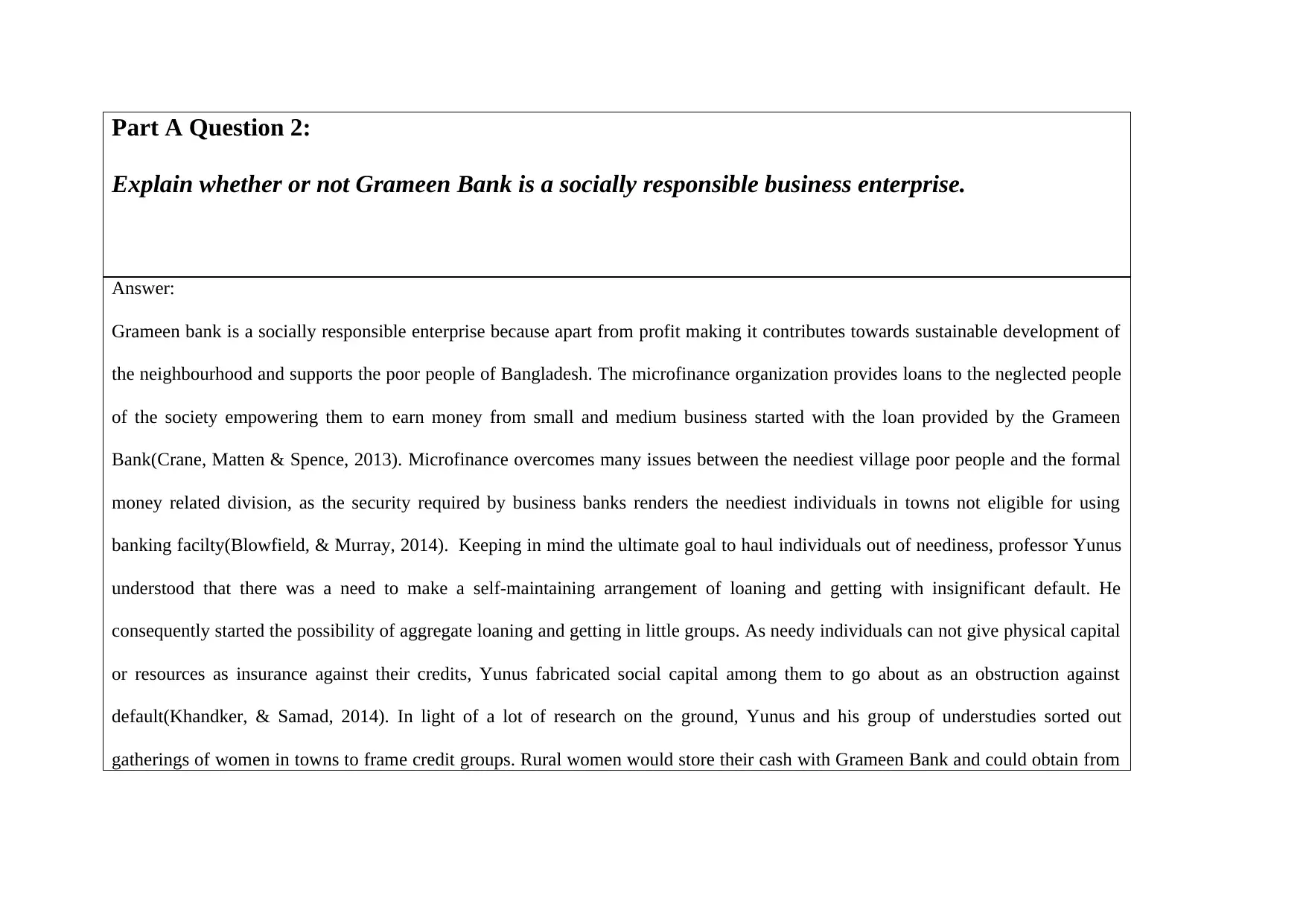
Part A Question 2:
Explain whether or not Grameen Bank is a socially responsible business enterprise.
Answer:
Grameen bank is a socially responsible enterprise because apart from profit making it contributes towards sustainable development of
the neighbourhood and supports the poor people of Bangladesh. The microfinance organization provides loans to the neglected people
of the society empowering them to earn money from small and medium business started with the loan provided by the Grameen
Bank(Crane, Matten & Spence, 2013). Microfinance overcomes many issues between the neediest village poor people and the formal
money related division, as the security required by business banks renders the neediest individuals in towns not eligible for using
banking facilty(Blowfield, & Murray, 2014). Keeping in mind the ultimate goal to haul individuals out of neediness, professor Yunus
understood that there was a need to make a self-maintaining arrangement of loaning and getting with insignificant default. He
consequently started the possibility of aggregate loaning and getting in little groups. As needy individuals can not give physical capital
or resources as insurance against their credits, Yunus fabricated social capital among them to go about as an obstruction against
default(Khandker, & Samad, 2014). In light of a lot of research on the ground, Yunus and his group of understudies sorted out
gatherings of women in towns to frame credit groups. Rural women would store their cash with Grameen Bank and could obtain from
Explain whether or not Grameen Bank is a socially responsible business enterprise.
Answer:
Grameen bank is a socially responsible enterprise because apart from profit making it contributes towards sustainable development of
the neighbourhood and supports the poor people of Bangladesh. The microfinance organization provides loans to the neglected people
of the society empowering them to earn money from small and medium business started with the loan provided by the Grameen
Bank(Crane, Matten & Spence, 2013). Microfinance overcomes many issues between the neediest village poor people and the formal
money related division, as the security required by business banks renders the neediest individuals in towns not eligible for using
banking facilty(Blowfield, & Murray, 2014). Keeping in mind the ultimate goal to haul individuals out of neediness, professor Yunus
understood that there was a need to make a self-maintaining arrangement of loaning and getting with insignificant default. He
consequently started the possibility of aggregate loaning and getting in little groups. As needy individuals can not give physical capital
or resources as insurance against their credits, Yunus fabricated social capital among them to go about as an obstruction against
default(Khandker, & Samad, 2014). In light of a lot of research on the ground, Yunus and his group of understudies sorted out
gatherings of women in towns to frame credit groups. Rural women would store their cash with Grameen Bank and could obtain from
Paraphrase This Document
Need a fresh take? Get an instant paraphrase of this document with our AI Paraphraser
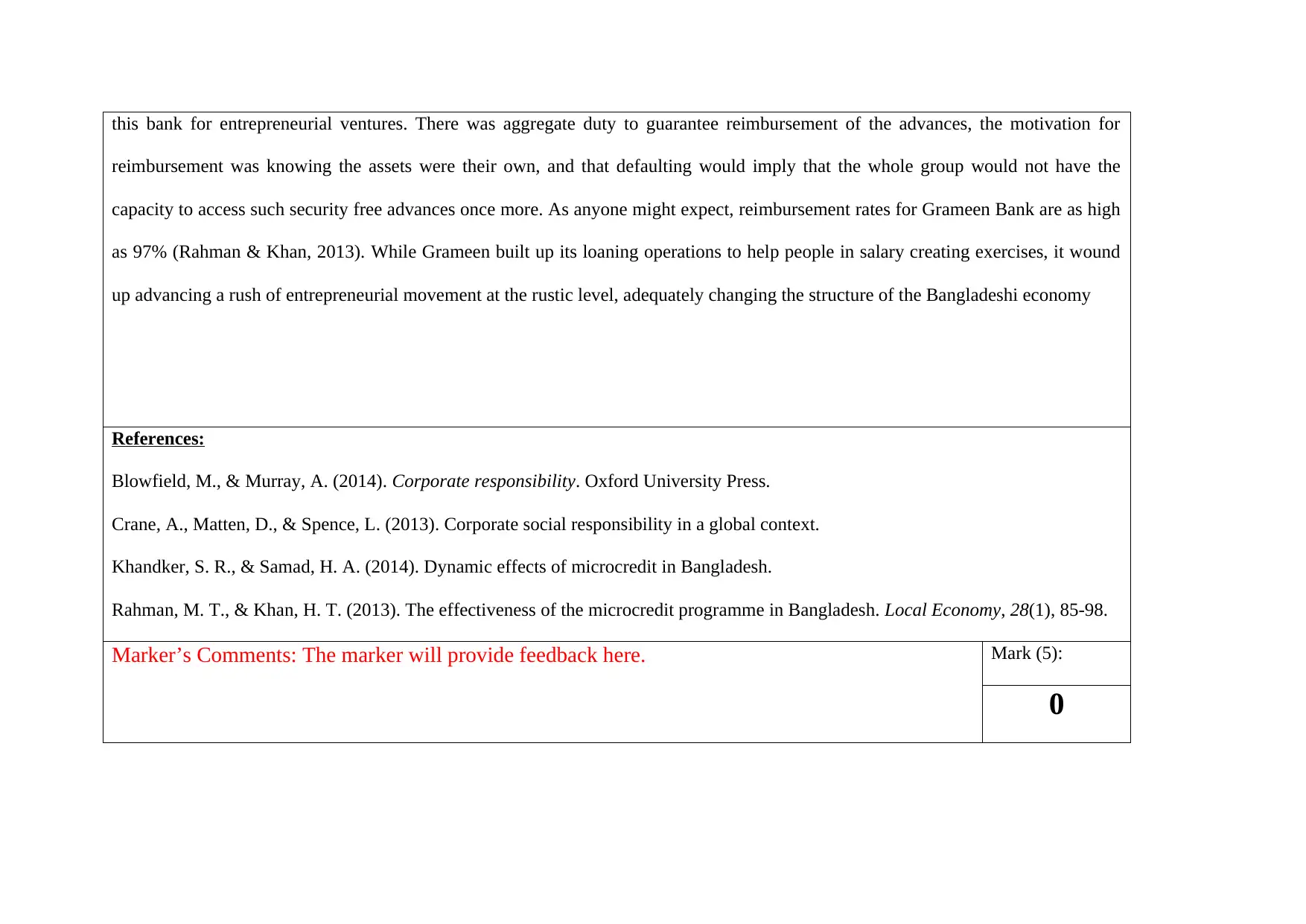
this bank for entrepreneurial ventures. There was aggregate duty to guarantee reimbursement of the advances, the motivation for
reimbursement was knowing the assets were their own, and that defaulting would imply that the whole group would not have the
capacity to access such security free advances once more. As anyone might expect, reimbursement rates for Grameen Bank are as high
as 97% (Rahman & Khan, 2013). While Grameen built up its loaning operations to help people in salary creating exercises, it wound
up advancing a rush of entrepreneurial movement at the rustic level, adequately changing the structure of the Bangladeshi economy
References:
Blowfield, M., & Murray, A. (2014). Corporate responsibility. Oxford University Press.
Crane, A., Matten, D., & Spence, L. (2013). Corporate social responsibility in a global context.
Khandker, S. R., & Samad, H. A. (2014). Dynamic effects of microcredit in Bangladesh.
Rahman, M. T., & Khan, H. T. (2013). The effectiveness of the microcredit programme in Bangladesh. Local Economy, 28(1), 85-98.
Marker’s Comments: The marker will provide feedback here. Mark (5):
0
reimbursement was knowing the assets were their own, and that defaulting would imply that the whole group would not have the
capacity to access such security free advances once more. As anyone might expect, reimbursement rates for Grameen Bank are as high
as 97% (Rahman & Khan, 2013). While Grameen built up its loaning operations to help people in salary creating exercises, it wound
up advancing a rush of entrepreneurial movement at the rustic level, adequately changing the structure of the Bangladeshi economy
References:
Blowfield, M., & Murray, A. (2014). Corporate responsibility. Oxford University Press.
Crane, A., Matten, D., & Spence, L. (2013). Corporate social responsibility in a global context.
Khandker, S. R., & Samad, H. A. (2014). Dynamic effects of microcredit in Bangladesh.
Rahman, M. T., & Khan, H. T. (2013). The effectiveness of the microcredit programme in Bangladesh. Local Economy, 28(1), 85-98.
Marker’s Comments: The marker will provide feedback here. Mark (5):
0
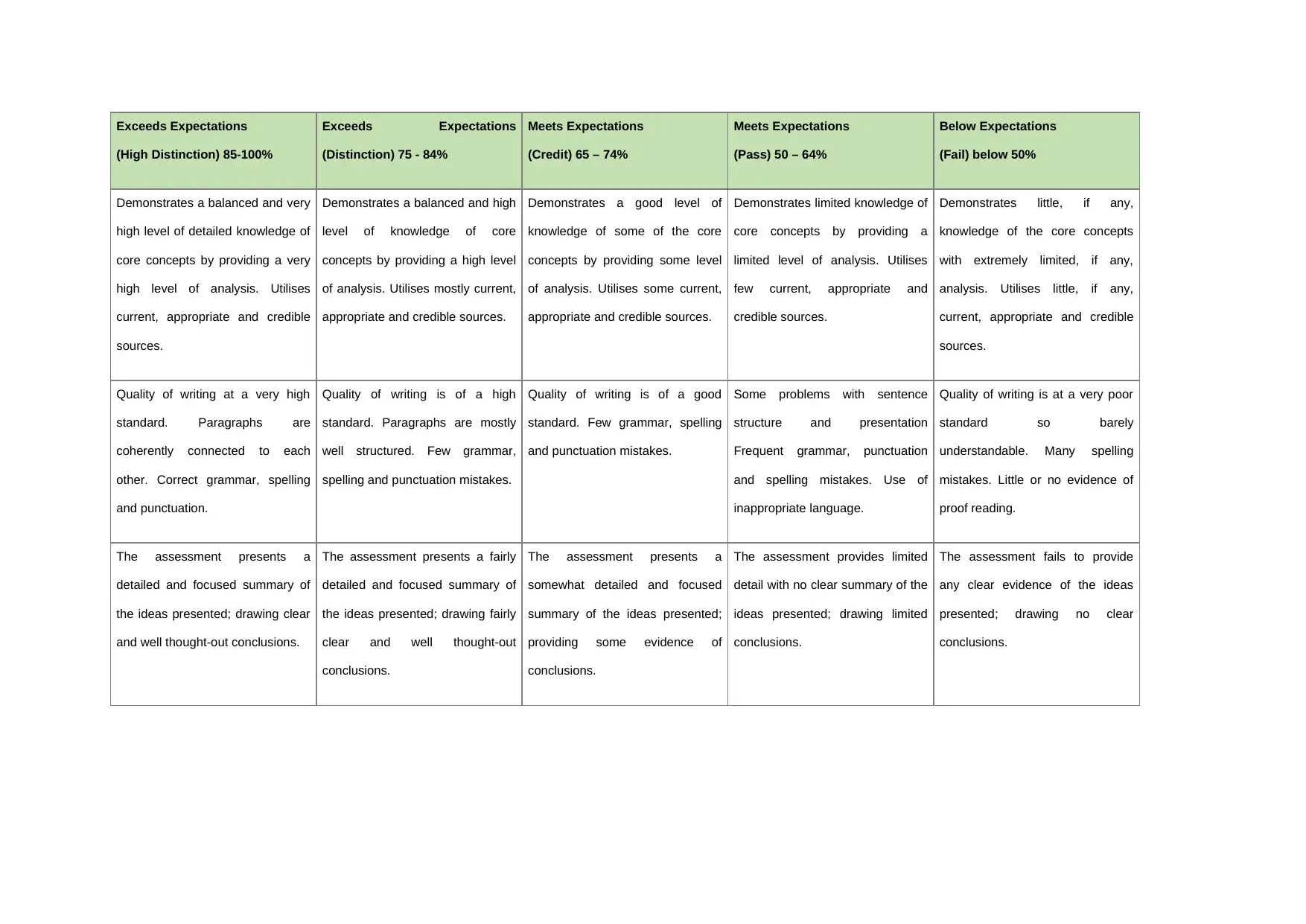
Exceeds Expectations
(High Distinction) 85-100%
Exceeds Expectations
(Distinction) 75 - 84%
Meets Expectations
(Credit) 65 – 74%
Meets Expectations
(Pass) 50 – 64%
Below Expectations
(Fail) below 50%
Demonstrates a balanced and very
high level of detailed knowledge of
core concepts by providing a very
high level of analysis. Utilises
current, appropriate and credible
sources.
Demonstrates a balanced and high
level of knowledge of core
concepts by providing a high level
of analysis. Utilises mostly current,
appropriate and credible sources.
Demonstrates a good level of
knowledge of some of the core
concepts by providing some level
of analysis. Utilises some current,
appropriate and credible sources.
Demonstrates limited knowledge of
core concepts by providing a
limited level of analysis. Utilises
few current, appropriate and
credible sources.
Demonstrates little, if any,
knowledge of the core concepts
with extremely limited, if any,
analysis. Utilises little, if any,
current, appropriate and credible
sources.
Quality of writing at a very high
standard. Paragraphs are
coherently connected to each
other. Correct grammar, spelling
and punctuation.
Quality of writing is of a high
standard. Paragraphs are mostly
well structured. Few grammar,
spelling and punctuation mistakes.
Quality of writing is of a good
standard. Few grammar, spelling
and punctuation mistakes.
Some problems with sentence
structure and presentation
Frequent grammar, punctuation
and spelling mistakes. Use of
inappropriate language.
Quality of writing is at a very poor
standard so barely
understandable. Many spelling
mistakes. Little or no evidence of
proof reading.
The assessment presents a
detailed and focused summary of
the ideas presented; drawing clear
and well thought-out conclusions.
The assessment presents a fairly
detailed and focused summary of
the ideas presented; drawing fairly
clear and well thought-out
conclusions.
The assessment presents a
somewhat detailed and focused
summary of the ideas presented;
providing some evidence of
conclusions.
The assessment provides limited
detail with no clear summary of the
ideas presented; drawing limited
conclusions.
The assessment fails to provide
any clear evidence of the ideas
presented; drawing no clear
conclusions.
(High Distinction) 85-100%
Exceeds Expectations
(Distinction) 75 - 84%
Meets Expectations
(Credit) 65 – 74%
Meets Expectations
(Pass) 50 – 64%
Below Expectations
(Fail) below 50%
Demonstrates a balanced and very
high level of detailed knowledge of
core concepts by providing a very
high level of analysis. Utilises
current, appropriate and credible
sources.
Demonstrates a balanced and high
level of knowledge of core
concepts by providing a high level
of analysis. Utilises mostly current,
appropriate and credible sources.
Demonstrates a good level of
knowledge of some of the core
concepts by providing some level
of analysis. Utilises some current,
appropriate and credible sources.
Demonstrates limited knowledge of
core concepts by providing a
limited level of analysis. Utilises
few current, appropriate and
credible sources.
Demonstrates little, if any,
knowledge of the core concepts
with extremely limited, if any,
analysis. Utilises little, if any,
current, appropriate and credible
sources.
Quality of writing at a very high
standard. Paragraphs are
coherently connected to each
other. Correct grammar, spelling
and punctuation.
Quality of writing is of a high
standard. Paragraphs are mostly
well structured. Few grammar,
spelling and punctuation mistakes.
Quality of writing is of a good
standard. Few grammar, spelling
and punctuation mistakes.
Some problems with sentence
structure and presentation
Frequent grammar, punctuation
and spelling mistakes. Use of
inappropriate language.
Quality of writing is at a very poor
standard so barely
understandable. Many spelling
mistakes. Little or no evidence of
proof reading.
The assessment presents a
detailed and focused summary of
the ideas presented; drawing clear
and well thought-out conclusions.
The assessment presents a fairly
detailed and focused summary of
the ideas presented; drawing fairly
clear and well thought-out
conclusions.
The assessment presents a
somewhat detailed and focused
summary of the ideas presented;
providing some evidence of
conclusions.
The assessment provides limited
detail with no clear summary of the
ideas presented; drawing limited
conclusions.
The assessment fails to provide
any clear evidence of the ideas
presented; drawing no clear
conclusions.
⊘ This is a preview!⊘
Do you want full access?
Subscribe today to unlock all pages.

Trusted by 1+ million students worldwide
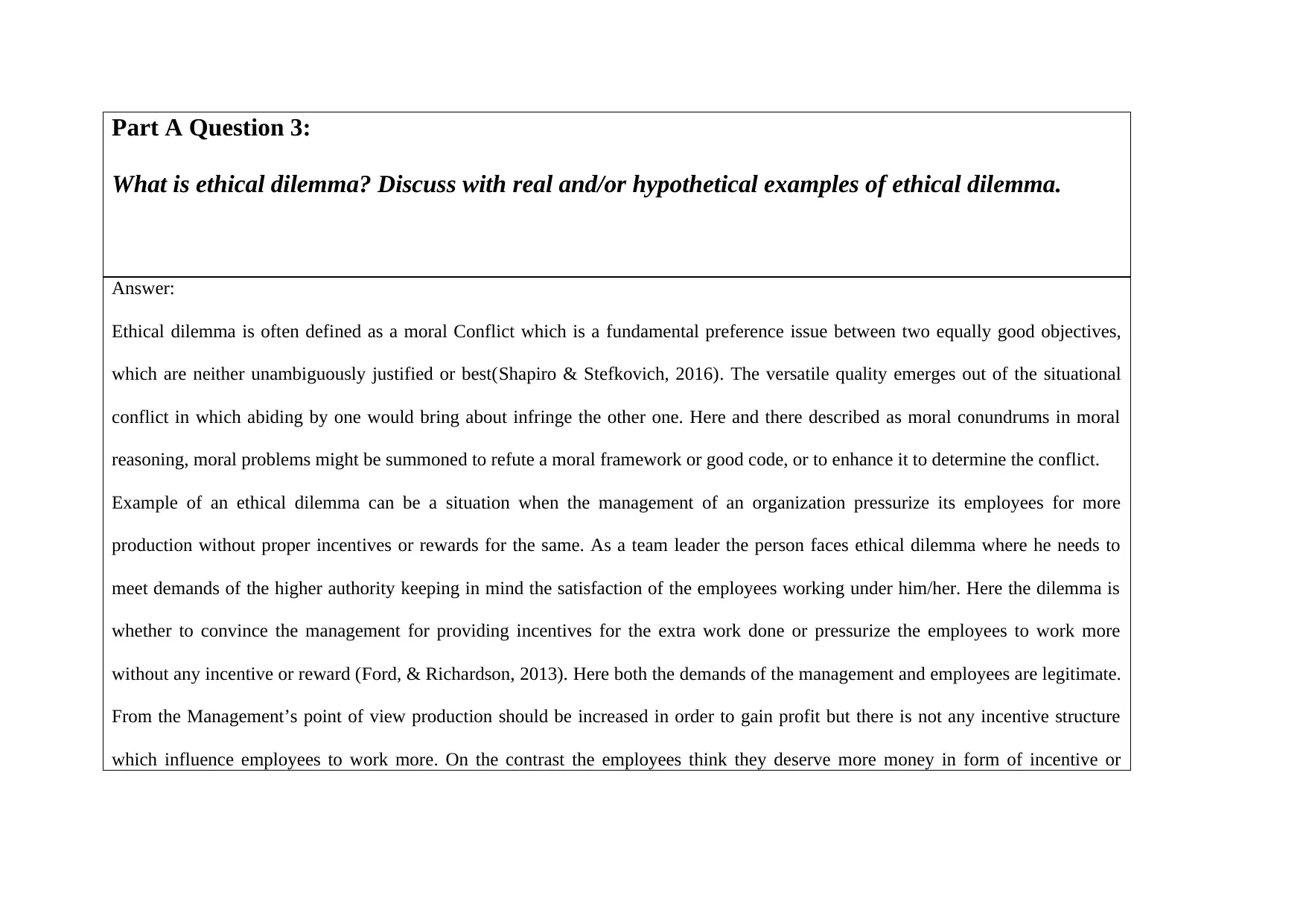
Part A Question 3:
What is ethical dilemma? Discuss with real and/or hypothetical examples of ethical dilemma.
Answer:
Ethical dilemma is often defined as a moral Conflict which is a fundamental preference issue between two equally good objectives,
which are neither unambiguously justified or best(Shapiro & Stefkovich, 2016). The versatile quality emerges out of the situational
conflict in which abiding by one would bring about infringe the other one. Here and there described as moral conundrums in moral
reasoning, moral problems might be summoned to refute a moral framework or good code, or to enhance it to determine the conflict.
Example of an ethical dilemma can be a situation when the management of an organization pressurize its employees for more
production without proper incentives or rewards for the same. As a team leader the person faces ethical dilemma where he needs to
meet demands of the higher authority keeping in mind the satisfaction of the employees working under him/her. Here the dilemma is
whether to convince the management for providing incentives for the extra work done or pressurize the employees to work more
without any incentive or reward (Ford, & Richardson, 2013). Here both the demands of the management and employees are legitimate.
From the Management’s point of view production should be increased in order to gain profit but there is not any incentive structure
which influence employees to work more. On the contrast the employees think they deserve more money in form of incentive or
What is ethical dilemma? Discuss with real and/or hypothetical examples of ethical dilemma.
Answer:
Ethical dilemma is often defined as a moral Conflict which is a fundamental preference issue between two equally good objectives,
which are neither unambiguously justified or best(Shapiro & Stefkovich, 2016). The versatile quality emerges out of the situational
conflict in which abiding by one would bring about infringe the other one. Here and there described as moral conundrums in moral
reasoning, moral problems might be summoned to refute a moral framework or good code, or to enhance it to determine the conflict.
Example of an ethical dilemma can be a situation when the management of an organization pressurize its employees for more
production without proper incentives or rewards for the same. As a team leader the person faces ethical dilemma where he needs to
meet demands of the higher authority keeping in mind the satisfaction of the employees working under him/her. Here the dilemma is
whether to convince the management for providing incentives for the extra work done or pressurize the employees to work more
without any incentive or reward (Ford, & Richardson, 2013). Here both the demands of the management and employees are legitimate.
From the Management’s point of view production should be increased in order to gain profit but there is not any incentive structure
which influence employees to work more. On the contrast the employees think they deserve more money in form of incentive or
Paraphrase This Document
Need a fresh take? Get an instant paraphrase of this document with our AI Paraphraser
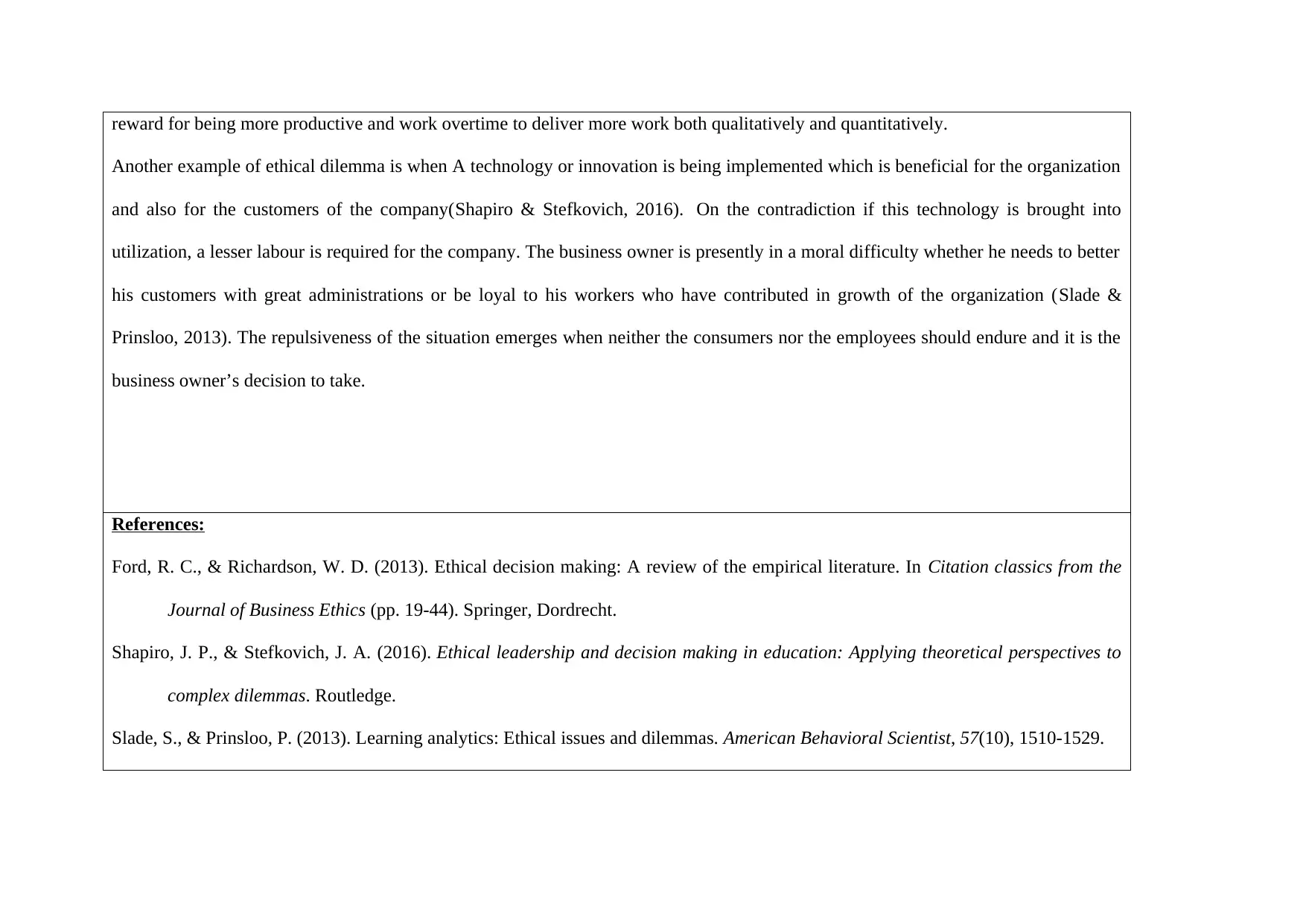
reward for being more productive and work overtime to deliver more work both qualitatively and quantitatively.
Another example of ethical dilemma is when A technology or innovation is being implemented which is beneficial for the organization
and also for the customers of the company(Shapiro & Stefkovich, 2016). On the contradiction if this technology is brought into
utilization, a lesser labour is required for the company. The business owner is presently in a moral difficulty whether he needs to better
his customers with great administrations or be loyal to his workers who have contributed in growth of the organization (Slade &
Prinsloo, 2013). The repulsiveness of the situation emerges when neither the consumers nor the employees should endure and it is the
business owner’s decision to take.
References:
Ford, R. C., & Richardson, W. D. (2013). Ethical decision making: A review of the empirical literature. In Citation classics from the
Journal of Business Ethics (pp. 19-44). Springer, Dordrecht.
Shapiro, J. P., & Stefkovich, J. A. (2016). Ethical leadership and decision making in education: Applying theoretical perspectives to
complex dilemmas. Routledge.
Slade, S., & Prinsloo, P. (2013). Learning analytics: Ethical issues and dilemmas. American Behavioral Scientist, 57(10), 1510-1529.
Another example of ethical dilemma is when A technology or innovation is being implemented which is beneficial for the organization
and also for the customers of the company(Shapiro & Stefkovich, 2016). On the contradiction if this technology is brought into
utilization, a lesser labour is required for the company. The business owner is presently in a moral difficulty whether he needs to better
his customers with great administrations or be loyal to his workers who have contributed in growth of the organization (Slade &
Prinsloo, 2013). The repulsiveness of the situation emerges when neither the consumers nor the employees should endure and it is the
business owner’s decision to take.
References:
Ford, R. C., & Richardson, W. D. (2013). Ethical decision making: A review of the empirical literature. In Citation classics from the
Journal of Business Ethics (pp. 19-44). Springer, Dordrecht.
Shapiro, J. P., & Stefkovich, J. A. (2016). Ethical leadership and decision making in education: Applying theoretical perspectives to
complex dilemmas. Routledge.
Slade, S., & Prinsloo, P. (2013). Learning analytics: Ethical issues and dilemmas. American Behavioral Scientist, 57(10), 1510-1529.
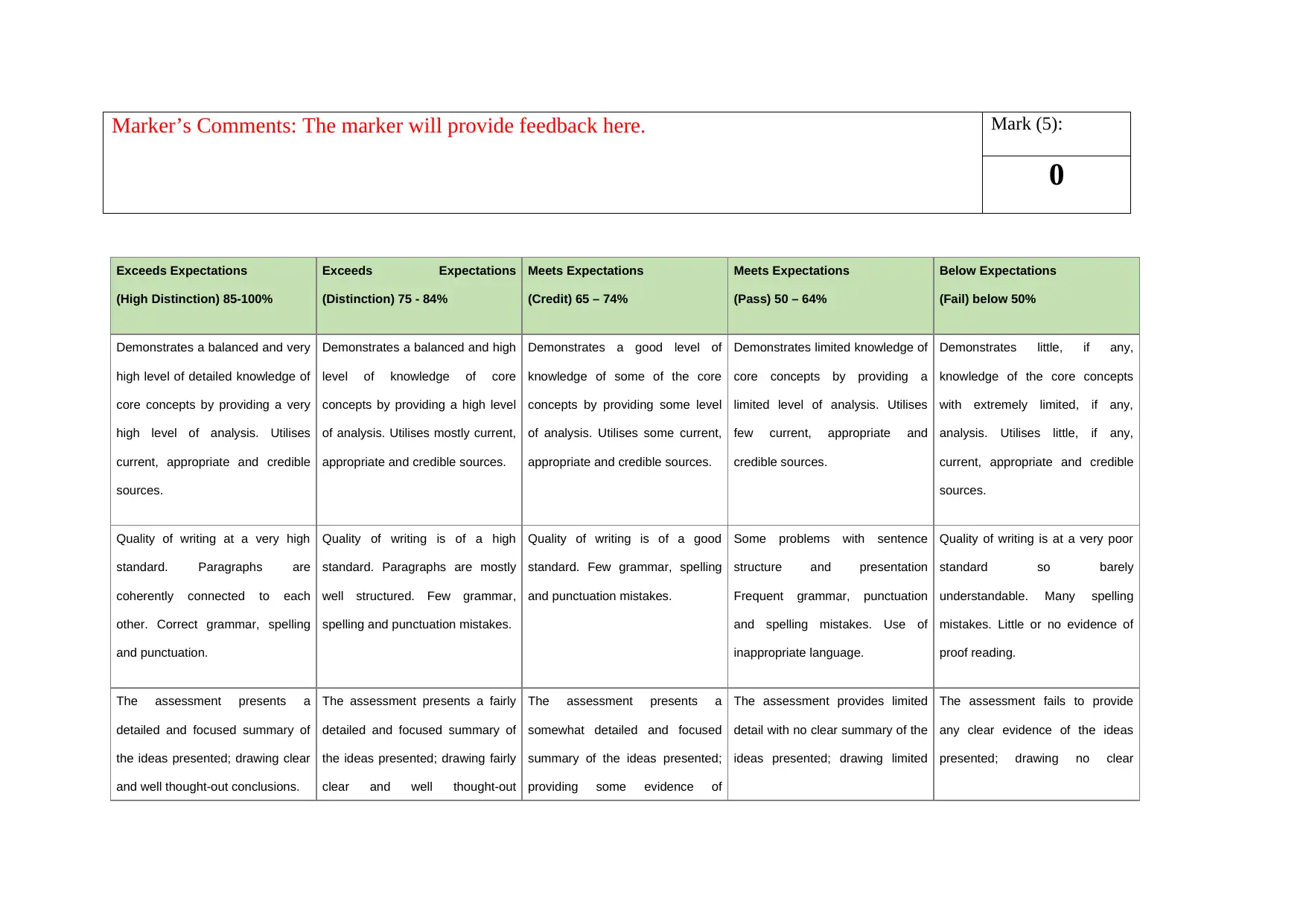
Marker’s Comments: The marker will provide feedback here. Mark (5):
0
Exceeds Expectations
(High Distinction) 85-100%
Exceeds Expectations
(Distinction) 75 - 84%
Meets Expectations
(Credit) 65 – 74%
Meets Expectations
(Pass) 50 – 64%
Below Expectations
(Fail) below 50%
Demonstrates a balanced and very
high level of detailed knowledge of
core concepts by providing a very
high level of analysis. Utilises
current, appropriate and credible
sources.
Demonstrates a balanced and high
level of knowledge of core
concepts by providing a high level
of analysis. Utilises mostly current,
appropriate and credible sources.
Demonstrates a good level of
knowledge of some of the core
concepts by providing some level
of analysis. Utilises some current,
appropriate and credible sources.
Demonstrates limited knowledge of
core concepts by providing a
limited level of analysis. Utilises
few current, appropriate and
credible sources.
Demonstrates little, if any,
knowledge of the core concepts
with extremely limited, if any,
analysis. Utilises little, if any,
current, appropriate and credible
sources.
Quality of writing at a very high
standard. Paragraphs are
coherently connected to each
other. Correct grammar, spelling
and punctuation.
Quality of writing is of a high
standard. Paragraphs are mostly
well structured. Few grammar,
spelling and punctuation mistakes.
Quality of writing is of a good
standard. Few grammar, spelling
and punctuation mistakes.
Some problems with sentence
structure and presentation
Frequent grammar, punctuation
and spelling mistakes. Use of
inappropriate language.
Quality of writing is at a very poor
standard so barely
understandable. Many spelling
mistakes. Little or no evidence of
proof reading.
The assessment presents a
detailed and focused summary of
the ideas presented; drawing clear
and well thought-out conclusions.
The assessment presents a fairly
detailed and focused summary of
the ideas presented; drawing fairly
clear and well thought-out
The assessment presents a
somewhat detailed and focused
summary of the ideas presented;
providing some evidence of
The assessment provides limited
detail with no clear summary of the
ideas presented; drawing limited
The assessment fails to provide
any clear evidence of the ideas
presented; drawing no clear
0
Exceeds Expectations
(High Distinction) 85-100%
Exceeds Expectations
(Distinction) 75 - 84%
Meets Expectations
(Credit) 65 – 74%
Meets Expectations
(Pass) 50 – 64%
Below Expectations
(Fail) below 50%
Demonstrates a balanced and very
high level of detailed knowledge of
core concepts by providing a very
high level of analysis. Utilises
current, appropriate and credible
sources.
Demonstrates a balanced and high
level of knowledge of core
concepts by providing a high level
of analysis. Utilises mostly current,
appropriate and credible sources.
Demonstrates a good level of
knowledge of some of the core
concepts by providing some level
of analysis. Utilises some current,
appropriate and credible sources.
Demonstrates limited knowledge of
core concepts by providing a
limited level of analysis. Utilises
few current, appropriate and
credible sources.
Demonstrates little, if any,
knowledge of the core concepts
with extremely limited, if any,
analysis. Utilises little, if any,
current, appropriate and credible
sources.
Quality of writing at a very high
standard. Paragraphs are
coherently connected to each
other. Correct grammar, spelling
and punctuation.
Quality of writing is of a high
standard. Paragraphs are mostly
well structured. Few grammar,
spelling and punctuation mistakes.
Quality of writing is of a good
standard. Few grammar, spelling
and punctuation mistakes.
Some problems with sentence
structure and presentation
Frequent grammar, punctuation
and spelling mistakes. Use of
inappropriate language.
Quality of writing is at a very poor
standard so barely
understandable. Many spelling
mistakes. Little or no evidence of
proof reading.
The assessment presents a
detailed and focused summary of
the ideas presented; drawing clear
and well thought-out conclusions.
The assessment presents a fairly
detailed and focused summary of
the ideas presented; drawing fairly
clear and well thought-out
The assessment presents a
somewhat detailed and focused
summary of the ideas presented;
providing some evidence of
The assessment provides limited
detail with no clear summary of the
ideas presented; drawing limited
The assessment fails to provide
any clear evidence of the ideas
presented; drawing no clear
⊘ This is a preview!⊘
Do you want full access?
Subscribe today to unlock all pages.

Trusted by 1+ million students worldwide
1 out of 21
Related Documents
Your All-in-One AI-Powered Toolkit for Academic Success.
+13062052269
info@desklib.com
Available 24*7 on WhatsApp / Email
![[object Object]](/_next/static/media/star-bottom.7253800d.svg)
Unlock your academic potential
Copyright © 2020–2025 A2Z Services. All Rights Reserved. Developed and managed by ZUCOL.




